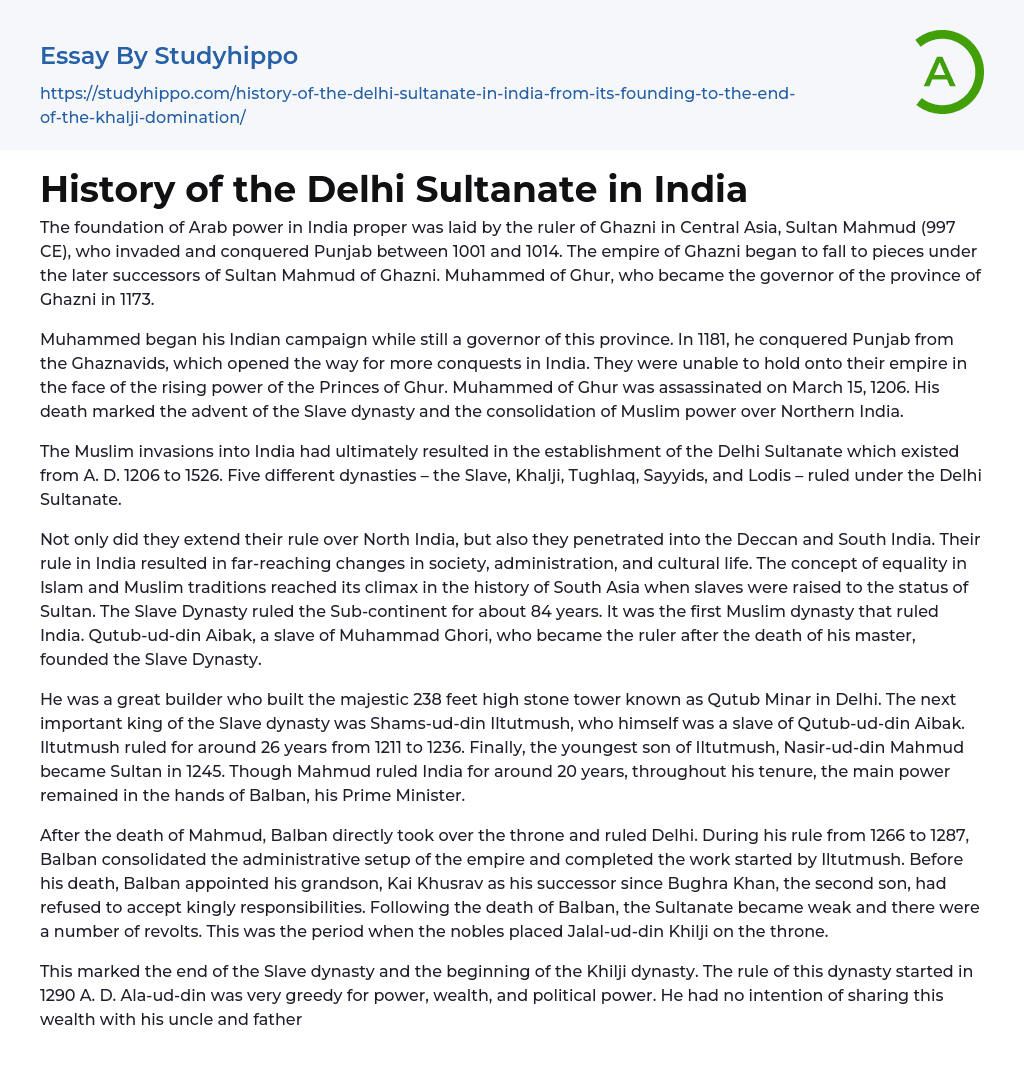The foundation of Arab power in India proper was laid by the ruler of Ghazni in Central Asia, Sultan Mahmud (997 CE), who invaded and conquered Punjab between 1001 and 1014. The empire of Ghazni began to fall to pieces under the later successors of Sultan Mahmud of Ghazni. Muhammed of Ghur, who became the governor of the province of Ghazni in 1173.
Muhammed began his Indian campaign while still a governor of this province. In 1181, he conquered Punjab from the Ghaznavids, which opened the way for more conquests in India. They were unable to hold onto their empire in the face of the rising power of the Princes of Ghur. Muhammed of Ghur was assassinated on March 15, 1206. His death marked the advent of the Slave dynasty and the consolidation of Muslim power over Northern India.
The Muslim invasions int
...o India had ultimately resulted in the establishment of the Delhi Sultanate which existed from A. D. 1206 to 1526. Five different dynasties – the Slave, Khalji, Tughlaq, Sayyids, and Lodis – ruled under the Delhi Sultanate.
Not only did they extend their rule over North India, but also they penetrated into the Deccan and South India. Their rule in India resulted in far-reaching changes in society, administration, and cultural life. The concept of equality in Islam and Muslim traditions reached its climax in the history of South Asia when slaves were raised to the status of Sultan. The Slave Dynasty ruled the Sub-continent for about 84 years. It was the first Muslim dynasty that ruled India. Qutub-ud-din Aibak, a slave of Muhammad Ghori, who became the ruler after the death of his master, founded the
Slave Dynasty.
He was a great builder who built the majestic 238 feet high stone tower known as Qutub Minar in Delhi. The next important king of the Slave dynasty was Shams-ud-din Iltutmush, who himself was a slave of Qutub-ud-din Aibak. Iltutmush ruled for around 26 years from 1211 to 1236. Finally, the youngest son of Iltutmush, Nasir-ud-din Mahmud became Sultan in 1245. Though Mahmud ruled India for around 20 years, throughout his tenure, the main power remained in the hands of Balban, his Prime Minister.
After the death of Mahmud, Balban directly took over the throne and ruled Delhi. During his rule from 1266 to 1287, Balban consolidated the administrative setup of the empire and completed the work started by Iltutmush. Before his death, Balban appointed his grandson, Kai Khusrav as his successor since Bughra Khan, the second son, had refused to accept kingly responsibilities. Following the death of Balban, the Sultanate became weak and there were a number of revolts. This was the period when the nobles placed Jalal-ud-din Khilji on the throne.
This marked the end of the Slave dynasty and the beginning of the Khilji dynasty. The rule of this dynasty started in 1290 A. D. Ala-ud-din was very greedy for power, wealth, and political power. He had no intention of sharing this wealth with his uncle and father-in-law.
Ala-ud-din Khilji, a nephew of Jalal-ud-din Khilji hatched a conspiracy and got Sultan Jalal-ud-din killed and proclaimed himself as the Sultan on July 19th, 1296. On October 3rd, 1296, Ala-ud-din was crowned as Sultan in the Red Palace of Balban. Ala-ud-din Khilji was the first Muslim ruler whose empire covered almost the whole of India up
to its extreme south. He fought many battles, conquered Gujarat, Ranthambhor, Chittor, Malwa, and Deccan. During his reign of 20 years, Mongols invaded the country several times but were successfully repulsed. From these invasions, Alla-ud-din Khilji learned the lessons of keeping himself prepared, by fortifying and organizing his armed forces.
Alla-ud-din died in 1316 A. D., and with his death, and soon the Khilji dynasty came to an end. Mubarak made people happy, plugged himself into a life of pleasure, and according to research written in Dr. Das’s assignment lecture notes, he spent the majority of his time drinking, listening to music, and giving out gifts during his short reign of four years and four months. Conditions were relatively peaceful; there were attacks by the Mongols, and only one huge rebellion in Devagiri, under Mubarak's reign. In 1320 he was assassinated by one of Khusrav’s aides, which leads to the end of the line of Khalji kings. Khusrav took the throne and title of Nasir-ud-din Khusrav Shah. He basically killed off any supporters of the Khalji reign one by one.
In September 1320, Nasir-ud-din Khusrav Shah was killed by a small army led by Ghazi Malik. Because there were no bloodlines or suitable successors to the throne, the nobles asked Malik to ascend the throne as Ghiyas-ud-din Tughlaq. This brought transition and disintegration to the Delhi Sultanate and passed the line of rulers to the Tughlaq.
- Russian Empire essays
- Ancient Greece essays
- British Empire essays
- Historical Figures essays
- Nazi Germany essays
- Roman Empire essays
- War essays
- Revolution essays
- 19Th Century essays
- Historiography essays
- History of the United States essays
- 20Th Century essays
- World History essays
- Vikings essays
- Declaration of Independence essays
- Civilization essays
- Evidence essays
- Genocide essays
- Colonialism essays
- Rebellion essays
- 1960S essays
- 1920S essays
- 1950S essays
- Letter from Birmingham Jail essays
- Louisiana Purchase essays
- The Columbian Exchange essays
- World Hunger essays
- What is History essays
- Bravery essays
- Gilded Age essays
- Vladimir Lenin essays
- Alexander The Great essays
- Sparta essays
- Victorian Era essays
- Henry v essays
- Stonehenge essays
- Frederick Douglass essays
- Mahatma Gandhi essays
- Joseph Stalin essays
- Geert Hofstede essays
- George Eliot essays
- Ginevra King essays
- John Keats essays
- Siegfried Sassoon essays
- Ben jonson essays
- Billy elliot essays
- Wilkie collins essays
- John Proctor essays
- Harriet Tubman essays
- Napoleon essays




